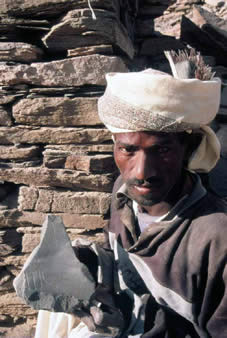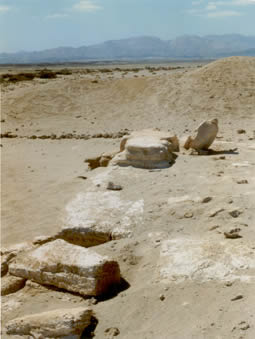

Fragment
of a Greek inscription, found in Sikait
3000 - 332 BC Pharaonic Period
332 - 30 BC Ptolemaic Period
30 BC - 395 AD Roman Period
395 - 642 AD Byzantine Period
642 AD - Islamic Period

The sand buried walls of the temple at Berenike
Although stated in several popular publications, there is no proof, archaeological or in ancient texts, of emerald mining in the Eastern Desert during the Pharaonic period. Ancient texts provide us with only a few clues on later emerald mining in the Sikait region. According to the writer Strabo (ca. 60 BC - 20 AD), emerald mining started in the Ptolemaic period. Nearly a century later Plutarch described how King Ptolemy XII, the father of Cleopatra (VII) gave the Roman general Lucullus a gold fitted emerald. The portrait of Ptolemy was engraved in the gemstone, which made it impossible for the general to refuse this gift without offending the king.
The first unequivocal mention of the Sikait region appears on stelae of the early Roman period. An inscription from the quarry at Wadi Umm Wikala dated 11 AD mentions the mines, as does a text carved on the Serapis temple in Berenike, which refers to the mining area as "the Land of the Green Stone". In 421 AD Olympiodorus visited the south of Egypt. In his account of his voyage he mentioned he had to obtain permission of the king of the Blemmyes, who controlled the area by that time, in order to visit the mines.